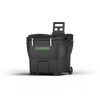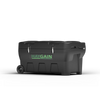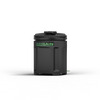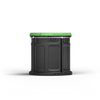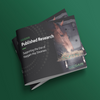Laminitis part 1 - Causes and prevention
In this first article Equine behavior specialist Sharon discusses the common causes for Laminitis, a complex and often misunderstood condition.

Sharon Smith MSc BHSAP
Accredited Behaviorist and Consultant, 23/03/2020

You can’t be around horses for very long before you hear about laminitis
The complexity of this potentially crippling condition is reflected in the variety of definitions, for example:
‘…a serious form of lameness in horses characterized by a hot, painful hoof, with bounding pulses that can be felt in the digital arteries…’ (University of Liverpool)
‘…damage to or failure of the laminae/lamellae…’ (thelaminitissite.org)
‘…a disease associated with ischaemia [inadequate blood supply] of digital dermal tissues, it is not primarily an inflammatory disease; hence lamin-itis is a misnomer…’ (laminitis.org)
The first definition suggests an over-supply of blood and clinical signs of inflammation. The third definition, an under-supply of blood, with reduced emphasis on inflammation. They’re all correct too – which is even more confusing!
Laminitis has been a rapidly developing area of research over the last few years, with new insights being discovered all the time. However, ‘damage of the laminae’ is constant in either the definition or explanation of clinical diagnosis. Let’s look closely at the foot initially, and then at how the damage may be caused.

Many owners assume the frog, sole and hoof wall spread the horse’s weight. In fact, pressure under the pedal bone in the foot actually decreases under load, so the frog and sole are not primary weight-bearing structures [1]. Instead, weight is transferred from the pedal bone, through soft tissue, to the underside of the hoof horn/wall. A special adaptation inside the hoof wall helps to carry the huge weight. There are hundreds of thin plates of hoof horn growing into the foot. It looks like the underside of a mushroom. These plates greatly increase the surface area available for soft tissue to attach to [2]. For clarity, I shall refer to the hard hoof plates as ‘lamellae’ and the inter-locking soft tissue folds as ‘laminae’. The all-important super-glue between the laminae and lamellae is called the ‘basement membrane’.
The importance of blood supply.
The basement membrane and laminae soft tissue are living cells and need a blood supply. Blood contains:
red blood cells - transporting oxygen in and carbon dioxide away
white blood cells (‘leukocytes’) - which help fight infection, release histamine (which triggers inflammation), envelop foreign bodies and assist with ‘mopping up’ fragments of damaged cells
platelets - which stop leakage by causing clots (in veins) and scabs (on the skin)
plasma - the liquid carrying the red and white blood cells and platelets. It also carries proteins, fats, dissolved salts, nutrients and hormones. But also carries bacteria, viruses and dissolved toxins.
As the horse walks, the load/unload cycle of the foot helps to pump incoming blood from arteries around the hoof through tiny capillaries, then back up the leg through the veins. Veins carry away all the waste products generated by the cells in the feet. Arteries dilate (widen) in healthy horses to allow more blood to repair or protect tissues. Veins and arteries also constrict (narrow) according to circumstance. Arteriovenous anastomoses (shunts) are a direct link from arteries to veins, which temporarily bypasses tiny capillaries and damaged tissue. Shunts open in response to high downstream blood pressure, to avoid bursting blood vessels. They also play a role in thermo-regulation. It is thought the horse foot has been 50 and 500 shunts per square centimeter of living foot [3]! PPID (Equine Cushing’s disease), elevated insulin and high cortisol levels in the circulatory system (eg. due to chronic stress), is thought to cause malfunction of these blood flow mechanisms. Blood flow changes are important for laminitis prevention, management and recovery. Dead cells aren’t sticky.
Small amounts of damage to soft laminae will cause structural changes within the foot, which may lead to abnormal hoof horn growth and gait changes. This can be managed and overcome, if spotted in time. There may be serious complications with greater damage. ‘Founder’ is partial separation of the laminae/lamellae, allowing the digital flexor tendon to pull and rotate the pedal bone downwards. ‘Sinker’ is another stage on, so called because all suspension is lost. Bones sink down in the foot, against the sole, and a rotated pedal bone may even puncture the sole.
The destruction of the basement membrane (between lamellae and laminae) seems to be due to one or more of: mechanical forces; laminae inflammation or abnormal cell growth/function.

Mechanical forces
Physically breaking apart the cells of the basement membrane. A potential problem with overweight horses, severe dietary deficiency or repetitive impact on hard surfaces. Alternatively, following inflammation, cell abnormality or death (see below). It may start with minor lamellae/laminae detachment under physical stress. The platelets in the blood patch-up the damage, but they also clog up the tiny veins leaving the laminae, causing damaging back-pressure, shunt activation, loss of blood supply to the laminae and further cell death (see below).
Inflammation
Inflammation is the result of tissue cells signaling for more blood to enter tissue to repair damage, deal with toxins, or deal with an invasive threat, such as harmful bacteria or virus. The tissue membranes become permeable, and so weaker, to allow the plasma and blood cells in. Chronic (low-level) inflammation (eg. a result of PPID or stress) means constantly weaker tissues. Blood arrives in the horse’s heel area first [2]. The additional nutrients used therein cause the heel area to grow quicker than the toe, and the tell-tail growth rings in the hoof. The outgoing blood is unrestricted, so pressures inside the hoof are stable and there is minimal pain, if any. The horse is still on the brink of full laminitis. One minor challenge and acute inflammation will allow more blood to flood into the laminae and swell. The solid hoof capsule stops outwards swelling. Inward swelling pushes the laminae/pedal bone away from the support of the lamellae. The forces through the pedal bone then continue to rip the basement membrane apart, separating the laminae from the lamellae. Platelets are activated by the resulting damage, restricting blood away from the foot too. All this pressure and pooling of blood in the foot causes pain, a hot hoof and a thumping pulse at the back of the fetlock. Shunts higher up will open to compensate for the increased pressure, reducing blood to the foot but eventually starving the laminae and basement membrane, so death of these structures will follow.
Abnormal growth/function of the basement membrane
Anything that causes cells to grow too quickly or not grow in the right way, will risk laminae detaching from the lamellae. For example, a horse has a broken leg, so constantly stands on the other leg/foot. A hard floor would compress the arteries against the pedal bone, cutting off the blood supply. A lack of oxygen and nutrients to the toe area causes basement membrane cell death. Another example is where high insulin levels directly damage the basement membrane across the whole hoof, without inflammation initially [4]. Insulin may trigger growth factors in the basement membrane [3], lengthening the hoof lamellae/laminae between pedal bone and hoof wall. This is structurally weaker – which is then ripe for a seemingly minor event to cause laminitis. Lamellae lengthening can be observed as a stretched ‘white line’ between the sole and hoof wall. High insulin levels and a stretched white line are associated with Equine metabolic syndrome (EMS), obesity, PPID/Equine Cushing’s disease and corticosteroids.
Triggers and risk factors
It is known that over consumption of starch and sugars overload the fore-gut, causing hind-gut fermentation and acidic conditions. The result is watery diarrhea (colitis), but not laminitis in all horses. A secondary mechanism is clearly at work. One proposal is the organic acids from the overloaded hind-gut increase circulatory blood lipo-polysaccharide (LPS). LPS in sufficient quantity both induces insulin resistance and leads to chronic inflammation, including in the lamellae [5]. Fructans in grass are often cited as triggering laminitis, but a direct link has not been found. Elevated blood sugars ARE a trigger (which can happen with sugary grass, but also starchy sweet feed and sweet hay) but these should not be such a threat if the insulin response is normal, and not resistant!
At a cellular level, there are only a few mechanisms that damage the lamellae and basement membrane. But those mechanisms can be triggered in a number of ways.
These risks are summarized in the following table:

Prevention relies on: avoiding high blood insulin levels; controlling cortisol/PPID, and appropriate hoof care.
So focus on: maintaining a healthy level of body fat; a balanced, low-carb, fibre-based diet; a low-stress but aerobically active lifestyle; avoiding fast work on hard ground and an appropriately supportive flooring/footing when not being exercised.
Read part 2 where Sharon discusses what the different treatments are trying to achieve, which may explain potentially conflicting advice.
How can Haygain help your horse?
Haygain is a science-driven company committed to improving equine health through research and innovation in respiratory and digestive health issues. Numerous scientific trials have shown that Haygain's high-temperature steaming eliminates 99% of dust, mold, bacteria and fungi in hay; effectively removing the health threat from respirable dust. Steaming hay will retain the nutritional value of hay and improve palatability.
In addition, Haygain hay steamers aid in the management of laminitic, colic-prone and post-operative horses and helps manage and prevent respiratory conditions such as IAD and Recurrent Airway Obstruction (RAO/COPD).
Developed by riders, for riders, we understand the importance of clean forage and a healthy stable environment for maintaining the overall well-being of the horse. Our hay steamers are recommended by many of the world’s leading riders, trainers and equine veterinarians. Find out more by clicking on one of the links below.
References
[1] DYHRE‐POULSEN, P., Smedegaard, H. H., Roed, J., & Korsgaard, E. (1994). Equine hoof function investigated by pressure transducers inside the hoof and accelerometers mounted on the first phalanx. Equine veterinary journal, 26(5), 362-366.
[2] Pollitt, C. C. (1992). Clinical anatomy and physiology of the normal equine foot. Equine Veterinary Education, 4(5), 219-224.
[3] Katz, L. M., & Bailey, S. R. (2012). A review of recent advances and current hypotheses on the pathogenesis of acute laminitis. Equine veterinary journal, 44(6), 752-761.
[4] Gauff, F., Patan‐Zugaj, B., & Licka, T. F. (2013). Hyperinsulinaemia increases vascular resistance and endothelin‐1 expression in the equine digit. Equine veterinary journal, 45(5), 613-618.
[5] Wearn, J. G., Suagee, J. K., Crisman, M. V., Corl, B. A., Hulver, M. W., Hodgson, D. R., ... & McCutcheon, L. J. (2012). Effects of the insulin sensitizing drug, pioglitazone, and lipopolysaccharide administration on markers of systemic inflammation and clinical parameters in horses. Veterinary immunology and immunopathology, 145(1-2), 42-49.
[6] Medina‐Torres, C. E., Underwood, C., Pollitt, C. C., Castro‐Olivera, E. M., Hodson, M. P., Richardson, D. W., & Eps, A. W. (2016). The effect of weightbearing and limb load cycling on equine lamellar perfusion and energy metabolism measured using tissue microdialysis. Equine veterinary journal, 48(1), 114-119.
